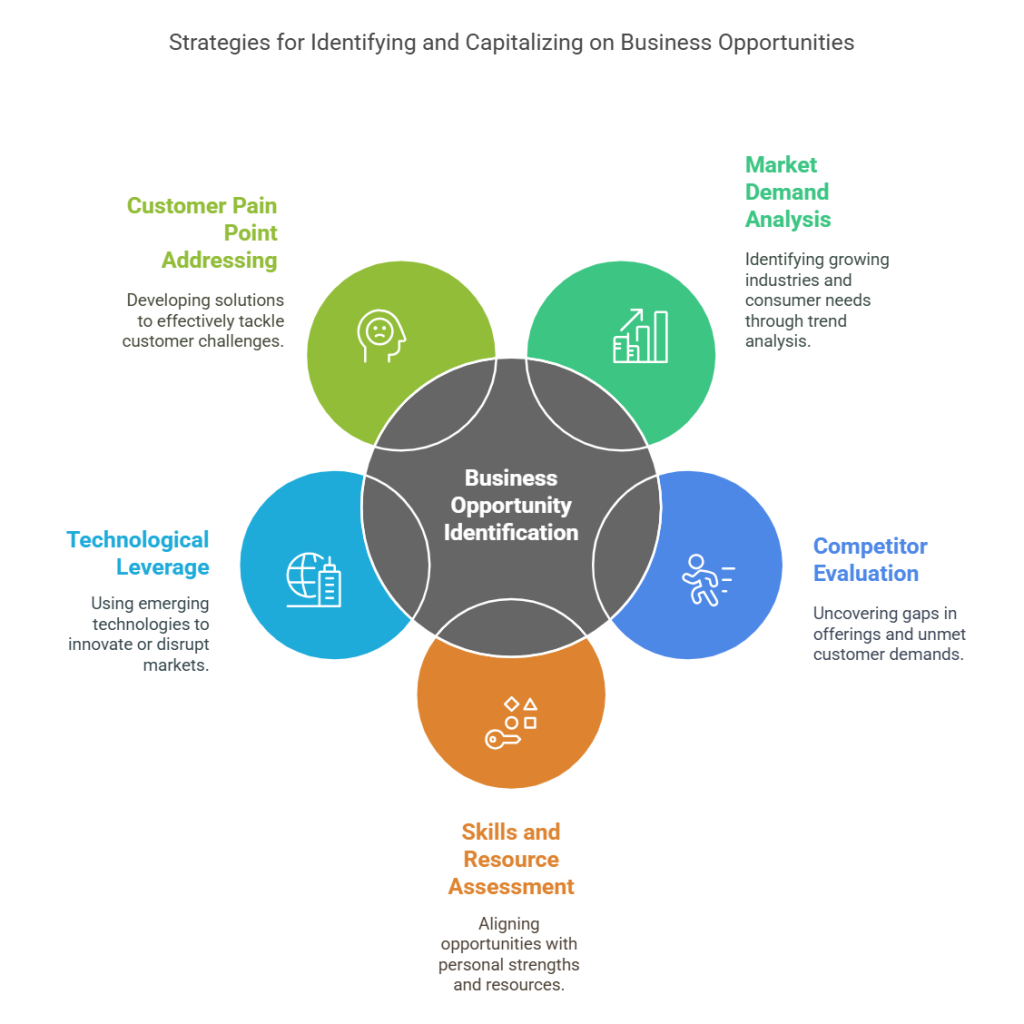
Testing ideas and gathering feedback is another important step in this process. Early validation allows you to refine your approach and reduce risks. Therefore, combining data, creativity, and adaptability gives you the tools to seize opportunities and stay ahead of the competition. Identifying these opportunities is not just about growth—it’s about creating a strong foundation for long-term success.
Analyzing Market Demand and Trends
Analyzing market demand and trends is a key step in identifying profitable business opportunities. By understanding what consumers want, you can align your offerings with their needs. However, it’s important to look beyond current preferences and focus on emerging trends that indicate future growth. This forward-thinking approach helps you stay ahead of competitors and adapt to changing markets.
Additionally, researching growing industries provides insights into areas with high-profit potential. You can examine factors like sales growth, consumer spending patterns, and technology adoption. These indicators often reveal untapped opportunities or markets with increasing demand. Therefore, focusing on industries with sustained growth can position your business for long-term success.
However, assessing market demand is not only about numbers. You should also consider customer feedback and reviews to understand what people value most. Observing shifts in behavior, like new purchasing habits or preferences, can uncover gaps in the market. This insight allows you to offer solutions that address unmet needs, which often leads to increased profitability.
Regularly monitoring market trends and demand ensures that your business remains relevant. By keeping a close eye on industry changes, you can spot opportunities before they become oversaturated. Identifying profitable business opportunities requires continuous research and adaptability, but these efforts often lead to sustainable growth and a competitive edge.
Evaluating Competitor Performance
Evaluating competitor performance is a key step in identifying profitable business opportunities. By analyzing their strengths and weaknesses, you can uncover gaps in their offerings. These gaps often point to unmet customer demands that your business can address. Additionally, understanding how competitors operate helps you position your services more effectively in the market.
However, competitor analysis is not just about finding flaws. You should also study what they do well, such as their pricing strategies or customer service practices. This insight can guide you in refining your approach or identifying areas where you can outperform them. Therefore, learning from their successes and failures gives you a strategic advantage.
Additionally, monitoring customer feedback about competitors can provide valuable insights. Negative reviews often reveal pain points that your business could resolve. Positive feedback highlights what customers prioritize, helping you understand which features or services to improve. By addressing these insights, you can differentiate your business and attract more customers.
Regularly evaluating your competition keeps you informed about changes in the market. When you identify gaps in their strategies, you gain opportunities to innovate and meet unfulfilled needs. Understanding your competitors’ performance is an essential part of staying competitive and positioning your business for success.
Assessing Your Skills and Resources
Assessing your skills and resources is an essential step in identifying profitable business opportunities. Understanding your strengths allows you to focus on areas where you have a competitive edge. Additionally, aligning your expertise with market demands increases the likelihood of success and reduces unnecessary risks.
However, it’s equally important to evaluate your available resources, such as time, capital, and team capabilities. By doing so, you can identify what’s feasible and avoid overextending your business. Matching opportunities with your resources ensures you pursue ventures that are sustainable and achievable. Therefore, a realistic assessment of your limitations helps you prioritize effectively.
Additionally, this process involves identifying gaps in your skills or resources that may need to be addressed. For example, you might consider seeking partnerships or outsourcing tasks to fill those gaps. By building on your strengths and addressing weaknesses, you position your business to seize opportunities with confidence.
Taking the time to assess your skills and resources helps you make informed decisions about where to invest your energy. This thoughtful approach not only maximizes profitability but also ensures that your efforts align with your goals. Identifying profitable business opportunities becomes easier when you know exactly what you bring to the table.
Leveraging Emerging Technologies
Leveraging emerging technologies is a powerful way to identify profitable business opportunities and stay ahead in a competitive market. Advancements in fields like artificial intelligence, automation, and data analytics are transforming industries. These technologies often create new ways to meet customer needs or improve existing processes. Additionally, adopting these innovations can help you streamline operations and reduce costs.
However, emerging technologies can also disrupt traditional markets, creating challenges for businesses that are slow to adapt. Staying informed about advancements allows you to anticipate changes and pivot as needed. By integrating new tools into your operations, you position your business to remain relevant and competitive. Therefore, keeping an eye on technology trends is essential for long-term growth.
Additionally, exploring how technology can enhance customer experiences often leads to new opportunities. For example, tools like virtual reality or chatbots offer creative ways to engage with your audience. These innovations help you differentiate your business and attract tech-savvy consumers. Focusing on how technology can solve specific problems can reveal valuable opportunities.
Regularly assessing emerging technologies enables you to identify opportunities that align with your goals. Investing in the right tools and strategies can open doors to markets previously out of reach. Leveraging these advancements not only improves your business but also helps you create solutions that resonate with your audience. By embracing change, you unlock the potential for growth and innovation.
Understanding Customer Pain Points
Understanding customer pain points is an important step in identifying profitable business opportunities. When you address problems that customers face, you create solutions that resonate with their needs. Additionally, focusing on these challenges helps you design products or services that stand out in a competitive market. This approach often leads to higher customer satisfaction and loyalty.
However, identifying pain points requires more than surface-level observations. You should engage directly with your audience through surveys, feedback, or interviews to gain deeper insights. Listening to their frustrations and unmet needs provides valuable information about what they truly want. Therefore, customer input is a key resource for refining your offerings and meeting expectations.
Additionally, addressing inefficiencies in existing products or processes can uncover new opportunities. For example, simplifying a complex process or offering a more convenient solution can attract customers looking for better options. These improvements not only solve their problems but also set your business apart. By focusing on pain points, you turn challenges into opportunities for growth.
Regularly evaluating customer needs ensures your business stays relevant and adaptable. Identifying and solving these issues positions you as a trusted provider of solutions. When customers feel understood, they are more likely to choose your offerings over competitors. This focus on solving real problems is a proven way to discover and capitalize on profitable opportunities.
Testing and Validating Business Ideas
Testing and validating business ideas is an essential step in identifying profitable business opportunities. By using low-cost methods like surveys or prototypes, you can gather valuable feedback before committing significant resources. Additionally, these approaches help you understand whether your idea aligns with market demand and customer needs.
However, simply testing an idea isn’t enough; you need to focus on gathering actionable insights. Pilot programs or small-scale launches can provide real-world data about how customers interact with your product or service. This information helps you identify potential improvements and refine your offering. Therefore, testing allows you to minimize risks and improve your chances of success.
Additionally, early validation helps you identify whether an idea is financially viable. Feedback from potential customers can indicate whether they’re willing to pay for your solution. This insight ensures that you pursue opportunities with real profit potential. By testing different approaches, you can discover what works best and avoid costly missteps.
Regularly validating your ideas also helps you adapt to changes in the market. Testing keeps you informed about shifting customer preferences and allows you to stay competitive. Identifying profitable business opportunities becomes easier when you rely on data and feedback to guide your decisions. This process not only reduces uncertainty but also strengthens your path to success.
Conclusion
Identifying profitable business opportunities requires a thoughtful approach and a willingness to adapt. By analyzing trends and understanding customer needs, you position your business for success. Additionally, evaluating your strengths and testing ideas helps you minimize risks and focus on what truly works.
However, success doesn’t come from a single step; it’s a continuous process of learning and improving. Regularly assessing your market and refining your strategies keeps you ahead of the competition. Therefore, combining research, feedback, and innovation allows you to uncover opportunities that drive growth and profitability.
Taking the time to explore these steps ensures your business remains flexible and ready for change. Identifying profitable business opportunities is an ongoing effort, but it leads to sustainable success and a stronger foundation for the future. By staying focused and proactive, you create a business that thrives in any environment.



